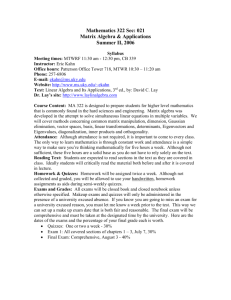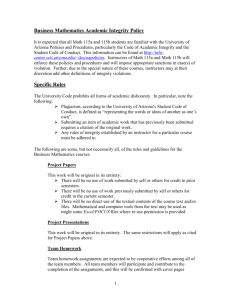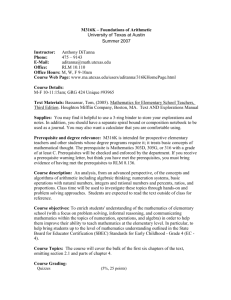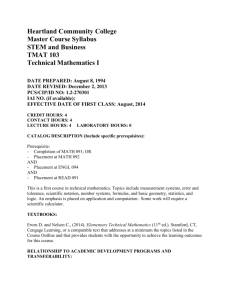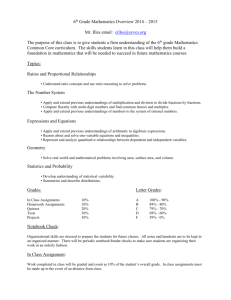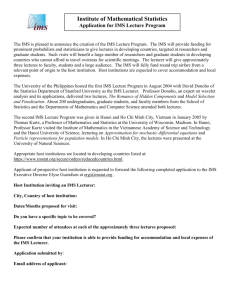Math 163 - Cynthia Pulley
advertisement
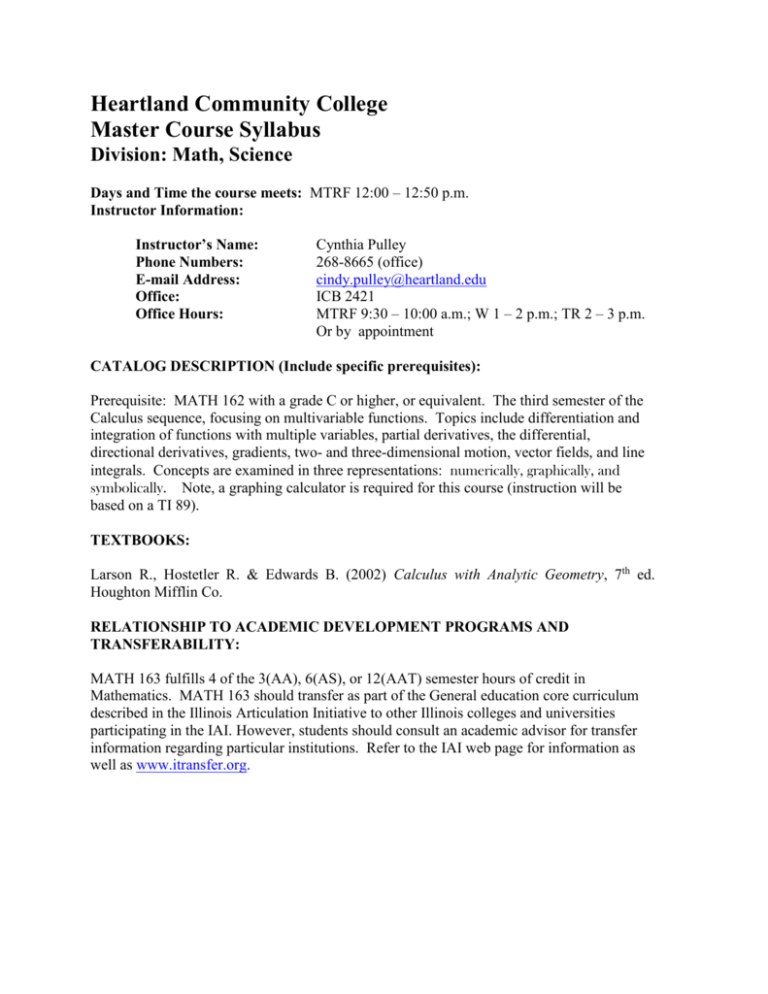
Heartland Community College Master Course Syllabus Division: Math, Science Days and Time the course meets: MTRF 12:00 – 12:50 p.m. Instructor Information: Instructor’s Name: Phone Numbers: E-mail Address: Office: Office Hours: Cynthia Pulley 268-8665 (office) cindy.pulley@heartland.edu ICB 2421 MTRF 9:30 – 10:00 a.m.; W 1 – 2 p.m.; TR 2 – 3 p.m. Or by appointment CATALOG DESCRIPTION (Include specific prerequisites): Prerequisite: MATH 162 with a grade C or higher, or equivalent. The third semester of the Calculus sequence, focusing on multivariable functions. Topics include differentiation and integration of functions with multiple variables, partial derivatives, the differential, directional derivatives, gradients, two- and three-dimensional motion, vector fields, and line integrals. Concepts are examined in three representations: numerically, graphically, and symbolically. Note, a graphing calculator is required for this course (instruction will be based on a TI 89). TEXTBOOKS: Larson R., Hostetler R. & Edwards B. (2002) Calculus with Analytic Geometry, 7th ed. Houghton Mifflin Co. RELATIONSHIP TO ACADEMIC DEVELOPMENT PROGRAMS AND TRANSFERABILITY: MATH 163 fulfills 4 of the 3(AA), 6(AS), or 12(AAT) semester hours of credit in Mathematics. MATH 163 should transfer as part of the General education core curriculum described in the Illinois Articulation Initiative to other Illinois colleges and universities participating in the IAI. However, students should consult an academic advisor for transfer information regarding particular institutions. Refer to the IAI web page for information as well as www.itransfer.org. COURSE OBJECTIVES (Learning Outcomes) Learning Outcomes Understand functions of many variables from graphical, symbolic, and numerical perspectives. Represent multiple quantities with vectors. GE code C3 CO2 Understand vector-valued functions. Apply differentiation techniques to functions with multiple variables. Optimize functions of several variables, with and without PS4 constraints. Apply integration techniques to multivariable functions. Determine mass, moments, and motion of particles in 2space and 3-space. CT3 Understand the properties and theorems (e.g., Stoke’s, Greene’s, etc.) essential for vector analysis. Assessment Exam, assignment, or project Exam, assignment, or project Exam, assignment, or project Exam, assignment, or project Exam, assignment, or project Exam, assignment, or project Exam, assignment, or project Exam, assignment, or project COURSE OUTLINE: 1. 2. 3. 4. 5. Vectors in the Plane and in Space Vector-Valued Functions Differentiation of Multivariable Functions Integration of Multivariable Functions Analysis of Vector Fields Method of Evaluation (Tests/Exams, Grading System): Student grades are based on successful completion of homework, quizzes, tests and other assignments as the instructor feels are necessary. Your grade is based upon cumulative total points. There is no weighting of grades for quizzes or exams, but these will be worth more points than your assignments. Exams may include comprehensive material and you will have a comprehensive final. Typically, you will have 4 – 6 exams throughout the semester and quizzes on a weekly basis. Your final exam will be worth approximately 20% of your final grade in this course. Grade Scale: 100 - 90% 89 - 80 79 - 70 69 - 60 59 -0 A B C D F Missing an exam and assignments policy: There are NO make-ups for exams or assignments except for excused absences from prior notification of the absence. Participation (or Attendance) Regular attendance is not only expected, but a must in order to be successful in this class. If a student is absent, it is his/her responsibility to obtain class notes and assignments from someone in the class. Incompletes An incomplete grade may be given to a student who, by the withdrawal date, can reasonably by expected to pass the course. Incompletes may be granted only when justified by extreme circumstances (e.g., serious illness, accident, death or serious illness in the immediate family). Incomplete grades are not given for such reasons as unjustified failure to appear for the final examination. A written agreement, outline the requirements to be met, must be signed by the instructor and the student. The agreed upon requirements must be completed no later than the end of the following semester. By the agreed upon date, the instructor will assign a grade or the incomplete will be changed to an F if the requirements are not completed. Required Writing and Reading: Required writing will be part of most assignments and tests. Students will be expected to explain how they found the solution, describe the solution graphically, and interpret the answer in the context of the problem. Students are expected to read the material in the textbook for each section studied. Student Responsibilities Before coming to class: Read assigned sections of the text. Attempt some of the assigned homework problems for the new section. During class: Ask questions regarding problems that gave you difficulty in solving. Actively listen and participate in class discussions and presentations of solutions. Take notes, not just what is written on the board, but any verbal explanations or clarifications given by the instructor or other students. After class: Reread notes and highlight what does not make sense or what you still do not understand so that you can ask clarifying questions during office hours or at the beginning of the next class. Do all of the assigned homework problems for the section discussed in class. Seek tutoring or instructor help when needed. Redo any missed problems on the homework, quizzes or tests. Student Conduct, Academic Integrity, Plagiarism Please refer to the Student Conduct Policy in the Heartland Community College CATALOG for specific policies concerning discipline, academic integrity and plagiarism. Heartland Library Information http://www.heartland.edu/library The Library, located in the Students Commons Buildings at the Raab Road campus, provides Heartland students with a full range of resources including books, online journal databases, videos, newspapers, periodicals, reserves, and interlibrary loan. Librarians are available to assist in locating information. Tutoring Center: http://www.heartland.edu/asc/tutor.html (309) 268-8231 Testing Center: http://www.heartland.edu/asc/testing.html (309) 268-8231 Academic Disabilities If you have a documented disability and wish to discuss academic accommodations, please contact Anita Moore at 268-8249 or anita.moore@heartland.edu. Syllabus Disclaimer: This syllabus is subject to change. Any changes will be announced in class. Important Dates Classes Begins Drop course with refund Labor Day (college closed) Mid-Term Break (college closed) Last day to withdraw and receive a “W” Thanksgiving Break (college closed) Class ends: Final Exam: I AM HERE TO HELP. I WILL DO MY BEST TO ANSWER QUESTIONS, PROVIDE ASSISTANCE WHEN REQUESTED AND SPEND EXTRA TIME WITH YOU AS NEEDED. YOUR SUCCESS IS IN YOUR HANDS. STUDY CONSISTENTLY AND DILIGENTLY, AND SEEK THE HELP YOU NEED. Appendix for AAT students Course Objectives/Standards for AAT students: based on the Illinois Mathematics Standards (IMS) for Teachers Upon completion of this course a student should be able to: Knowledge Objectives Graph, differentiate and integrate parametric curves. (IMS 2A, 3A, 4B, 5A) Graph, differentiate and integrate curves given in polar coordinates, including conic sections. (IMS 2A, 3A, 5A) Write equations of lines and planes in space, including equations of tangent planes and equations of normal lines. (IMS 2A, 3A) Differentiate and integrate vector functions in two & three dimensions. (IMS 3A, 4B) Apply calculus, using vectors, to study motion in space and in other situations. (IMS 2A, 3A, 4B) Explain the concept of limits & continuity in functions of several variables. (IMS 3A) Find differentials, directional derivatives and gradients of functions of several variables. (3A, 5A) Find extrema of functions in two variables, including using Lagrange Multipliers. (IMS 3A, 4B, 5A) Simplify indefinite and evaluate definite double integrals. (IMS 3A) Use double integrals in applications. (IMS 2A, 3A, 4B, 5A) Simplify indefinite and evaluate definite triple integrals, including triple integrals using cylindrical and spherical coordinates. (IMS 3A) Use triple integrals in applications. (IMS 2A, 3A, 4B, 5A) Performance Objectives Graph, differentiate and integrate parametric curves. (IMS 2C, 3B, 6C1, 7C8, 8C1, 8C4, 8C5, 8C6) Graph, differentiate and integrate curves given in polar coordinates, including conic sections. (IMS 2C, 3B, 6C1, 6D1, 7C8, 8C1, 8C2, 8C5, 8C6) Use cylindrical & spherical coordinates to write equations of three dimensional figures. (IMS 2C, 6C2, 6D1, 7C8, 8C6) Write equations of lines and planes in space, including equations of tangent planes and equations of normal lines. (IMS 2C, 7C8, 8C5, 8C6) Differentiate and integrate vector functions in two & three dimensions. (IMS 2C, 6C1, 7C8, 8C1, 8C5, 8C6) Apply calculus, using vectors, to study motion in space and in other situations. (IMS 2C, 6C2, 7C8, 8C1, 8C2, 8C5, 8C6) Explain the concept of limits & continuity in functions of several variables. (IMS 2C, 3B, 7C8, 8C4, 8C5, 8C6) Find partial derivatives of functions of several variables. (IMS 2C, 3B, 6D1, 7C8, 8C1, 8C4, 8C6) Find differentials, directional derivatives and gradients of functions of several variables. (6D1, 7C8, 8C1, 8C5) Find extrema of functions in two variables, including using Lagrange Multipliers. (IMS 2C, 6C1, 6D1, 7C8, 8C1, 8C4, 8C5, 8C6) Simplify indefinite and evaluate definite double integrals. (IMS 2C, 3B, 6C1, 6D1, 7C8, 8C5, 8C6) Use double integrals in applications. (IMS 2C, 3B, 6C1, 6D1, 6D3, 7C8, 8C5, 8C6) Simplify indefinite and evaluate definite triple integrals, including triple integrals using cylindrical and spherical coordinates. (IMS 2C, 3B, 6C1, 6D1, 7C8, 8C5, 8C6) Use triple integrals in applications. (IMS 2C, 3B, 6C1, 6D1, 6D3, 7C8, 8C5, 8C6) The following competencies/objectives are strongly recommended for inclusion in Calculus III. However, they are not part of the IAI description for Calculus III. Knowledge Objectives • Understand vector fields. (IMS 2A, 3A, 4B) • Find/evaluate line integrals. (IMS 2A, 3A, 4B) Performance Objectives • Understand vector fields. (IMS 2C, 3C, 6D1, 7C8, 8C5, 8C6) • Find/evaluate line integrals. (IMS 2C, 3B, 6C1, 7C8, 8C5, 8C6) • Use Green’s Theorem. (IMS 8C5, 8C6) AAT students should be collecting assignments, assessments and artifacts that show competence in the following standards. Some suggestions for what to collect are as follows: Sample of Acceptable Course Assignments/Assessments/Artifacts (by Standard and Indicator) 2A Knowledge Indicator The competent teacher of mathematics understands the many strategies for problem solving. Evaluations of homework problems or class discussions or problem/project presentations or quizzes/exams; Reflective writing on problem solving; Writing/analyzing multiple solution strategy problem solving; Peer tutoring on problem solving strategies 2C Performance Indicator The competent teacher of mathematics generalizes results of problems and extends them to other problem situations. Evaluations of homework problems or class discussions or problem/project presentations or quizzes/exams that demonstrate the ability to generalize mathematical properties from specific cases/problems and formulate theorems or discover more general situations where such properties apply. 3A Knowledge Indicator The competent teacher of mathematics understands various ways of reasoning with respect to concepts procedures and conjectures. Evaluations of homework problems or class discussions or problem/project presentations or quizzes/exams; Reflective writing on reasoning; Completion of proofs; Peer tutoring on reasoning. 3B Performance Indicator The competent teacher of mathematics applies mathematical reasoning and appropriate technologies in the development of concepts, procedures and conjectures. Evaluations of homework problems or class discussions or problem/project presentations or quizzes/exams; Reflective writing on reasoning with technology; Completion of proofs; Peer tutoring on reasoning with technology. 3C Performance Indicator The competent teacher of mathematics generalizes reasoning skills within the study of mathematics and applies or extends them to other contexts. Evaluations of homework problems or class discussions or problem/project presentations or quizzes/exams; Reflective writing on reasoning; Completion of proofs; Peer tutoring on reasoning. 4B Knowledge Indicator The competent teacher of mathematics understands mathematical connections to other disciplines. Evaluations of homework problems or class discussions or problem/project presentations or quizzes/exams; Reflective writing on mathematics and how it relates to other disciplines. 4E Performance Indicator The competent teacher of mathematics connects mathematics to other disciplines. Evaluation or class discussions of problem/project presentations Reflective writing on mathematics and how it relates to other disciplines 5A Knowledge Indicator The competent teacher of mathematics becomes familiar with the capabilities and benefits of current and emerging technologies. Evaluations of appropriate use of technology on homework problems or class discussions or problem/project presentations or quizzes/exams requiring the use of technology: programming language or graphing calculator or mathematics software or internet resources or power point. 6A5 Knowledge Indicator The competent teacher of mathematics knows and understands polar and vector representations of complex numbers. Evaluations of homework problems, class discussions, problems/project presentations, quizzes/exams 6C1 and 6C2 Performance Indicator The competent teacher of mathematics uses number sense to judge the reasonableness of results and applies proportional reasoning to solve problems. Use number sense and proportional reasoning in the solving of calculus problems (finding extrema, points of inflections, asymptotes, max/min problems, related rates, Newton’s Method) as evaluated by homework problems or class discussions or problem/project presentations or quizzes/exams; Reflective writing; Peer tutoring on number sense and proportional reasoning. 6D1 and 6D2 Performance Indicator The competent teacher of mathematics chooses appropriately from mental math, paper and pencil, manipulative, and technology to perform calculations and models, develops and applies algorithms with technology. Evaluations of appropriate use of algorithms with or without technology to solve problems as evidenced by homework problems or class discussions or problem/project presentations or quizzes/exams. Reflective writing; Peer tutoring on use of algorithms with or without technology to solve problems. 6D3 Performance Indicator The competent teacher of mathematics demonstrates the uses of numerical approximations as a basis for numerical integration and numerical-based proofs. Evaluations of ability to apply and use numerical integration to approximate results and solve problems as evidenced by homework problems or class discussions or problem/project presentations or quizzes/exams; Reflective writing. 7C8 Performance Indicator The competent teacher of mathematics uses modeling and visualization to hypothesize about and predict measurements. Evaluations of homework problems or class discussions or problem/project presentations or quizzes/exams on modeling areas under curve as summation of rectangles and use of slices and shells to visualize volume. 8C1, 8C2, and 8C4 Performance Indicator The competent teacher of mathematics understands concepts of rates of change, patterns leading to limits, distance, area, volume, shapes that lead to limits, and concepts of limits. Evaluations of homework problems or class discussions or problem/project presentations or quizzes/exams; Reflective writing; Completion of proofs involving limits and how they relate to rates of change, distance, area, and volume. 8C5 and 8C6 Performance Indicator The competent teacher of mathematics understands the basic concepts of calculus, analytic geometry and their applications. Evaluations of homework problems or class discussions or problem/project presentations or quizzes/exams; Reflective writing; Completion of proofs on ALL aspects of calculus: derivatives, integrals, continuity, limits, applications. 8G3 Performance Indicator The competent teacher of mathematics uses differentiation, integration, and other concepts of calculus to solve problems and interpret results. Evaluations of homework problems or class discussions or problem/project presentations or quizzes/exams
